I was 18 years old and in a dusty little jeep when I saw my first wild bear. It was grab-a-blanket kind of cold, as Indian sal forests are on wintry mornings; but Ranthambhore – better known for its Bengal tigers – infused the mood with a tropical vibe. Golden land speckled with trees collapsed into a valley beside us, and on the further ridge a sloth bear waddled by, on some errand known only to itself.
I don’t know how many bears I’ve seen since – hundreds, maybe thousands. Black bears and grizzlies dominated my days in western Canada. They leave their tracks, they smash their trees, and they try to live amidst people who only grudgingly tolerate them.

This huge male grizzly was in Jasper, Alberta. We’re always looking for a symbol for Wilderness, it seems. Bears are the spirit of mountain and taiga. There is no wilderness without large carnivores, but it doesn’t follow that large carnivores only live in wilderness.
People have now taken over practically all the Earth. If we cannot work out how to conserve wolves and bears in human-dominated landscapes, we will lose them everywhere. No national park is big enough – and some places have plenty of bears without having parks at all…
9th July 2016
There is hope for Europe’s large carnivores, maybe; it depends how you weave this fragile thread of human psychology. It all began this morning – I was standing, Newton-like, under the apple tree on the edge of our orchard-camp, awaiting today’s group. We are plunging into the unknown, where no large mammal survey team has gone before.
Choosing a new transect is an exciting business in a forest where any given track might spit you into a monstrous boggy bramble patch. The Hiking Pole gets a taste of bushwhacking.
But we strike gold.
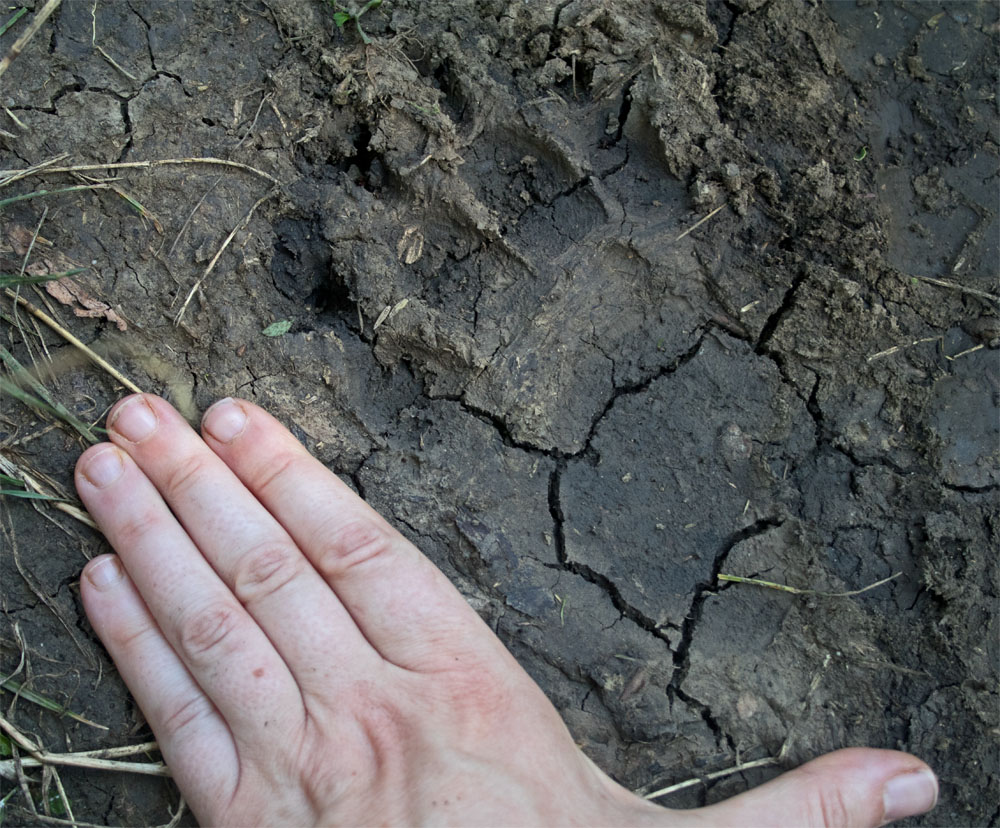
This is the footprint of a fairly small bear, living and breathing in a working landscape. Full of people, full of bears. Of course, a track is an invitation to take a plaster cast, like we did back in Richis.
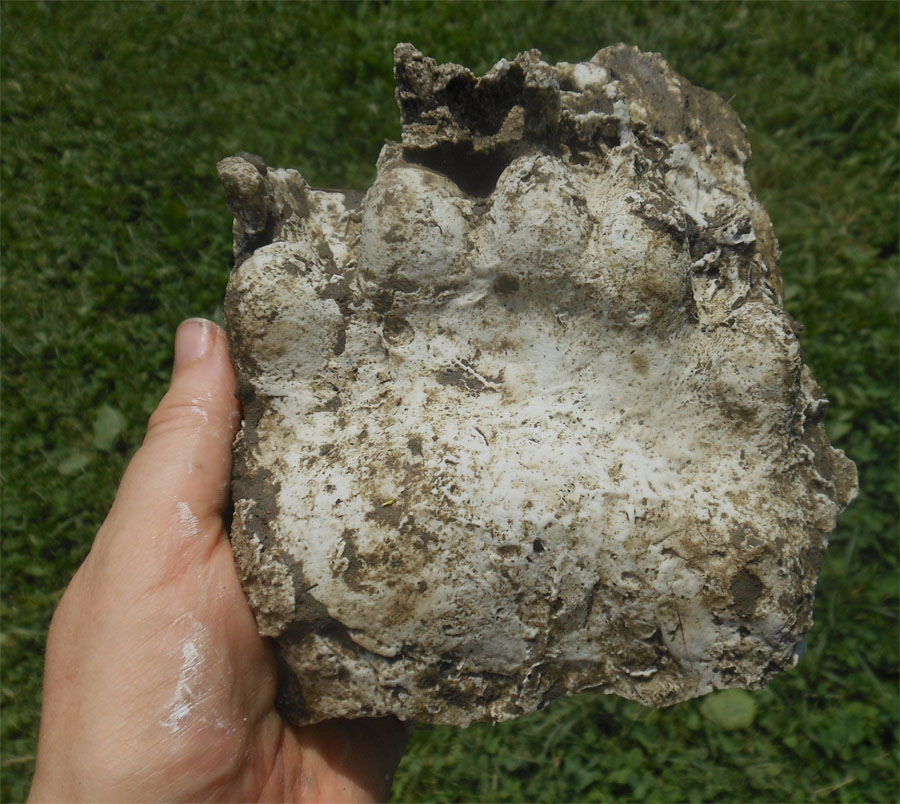
There’s no realistic prospect of actually meeting a bear within these rolling forests. They hear us and scatter, leaving the trees as silent witnesses.
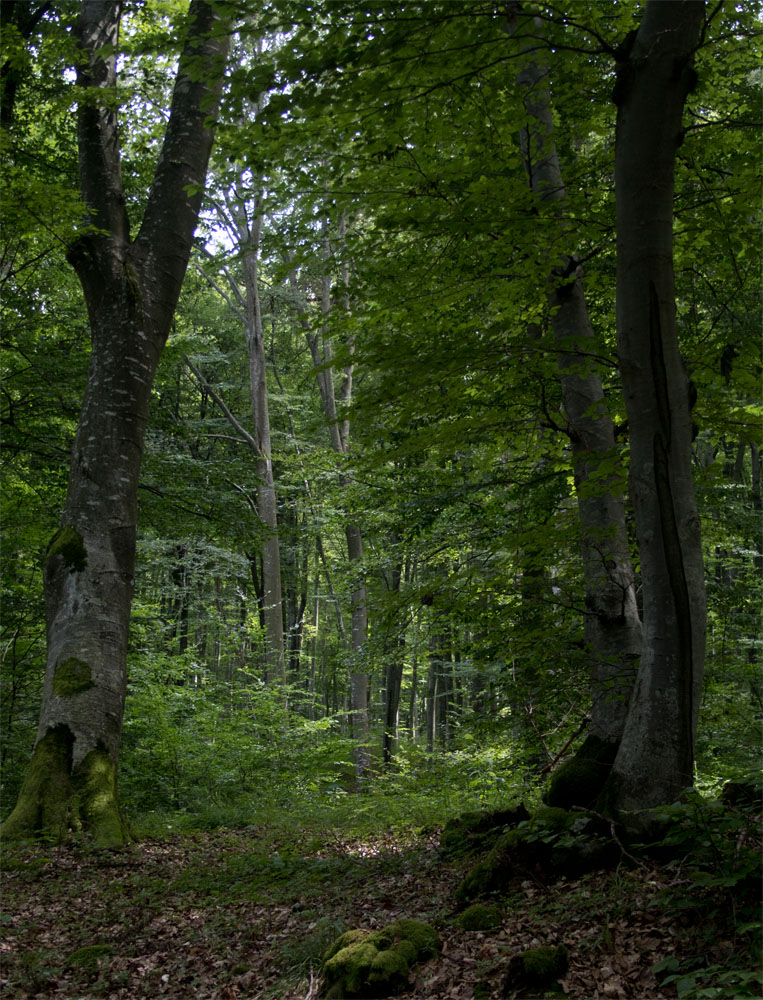
So, come evening, we try something else.
Time drifts on. Clouds build into a grey matrix; rain spits, and stops again. I’m joining two university students with A. on a wildlife search tonight. He arrives smartly in a little dark jeep. He’s about forty, with a shaved head and thickset features – and he knows his stuff. We have only been driving for a few minutes when I ask, almost ironically, whether the striped feline sitting in the grass is a domestic cat. It has to be.
Really.
It isn’t.
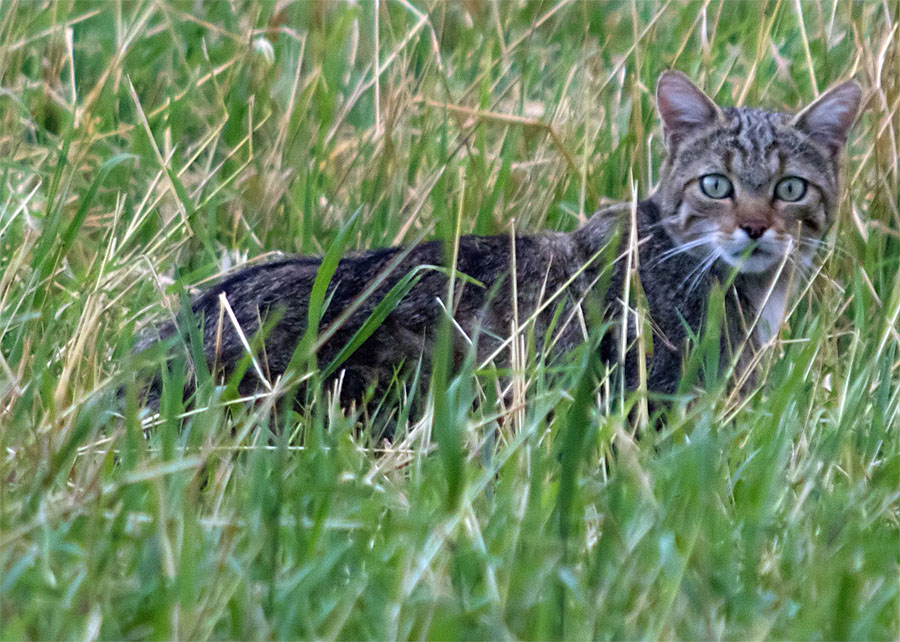
It’s a forest wildcat, one of the rarest and most elusive animals in Europe. It resembles a tabby because it’s related to the ancestor of our pet cats, but genetically is a very different kettle of fish. Scotland calls them Highland Tigers; they’re extinct in England. Untameable, almost mythological, this is the cat that hunted Europe’s forests long before people came to name them.
Romania has one of the most robust wildcat populations still surviving. They are considerably bigger than pet cats, but also be distinguished by their neck stripes, dorsal stripe and, most of all, that thick banded tail.
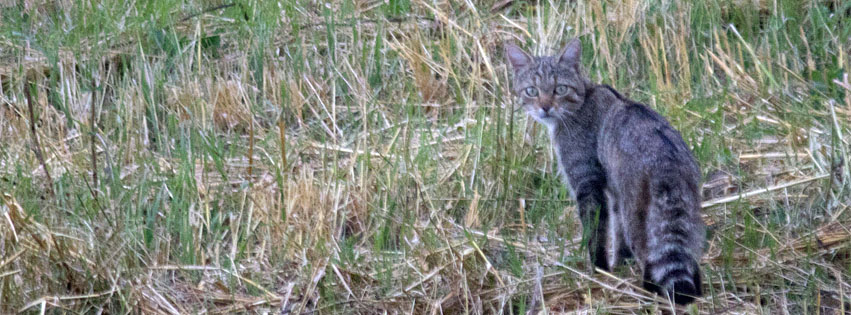
I’m stunned.
Onward, past a crumbling village with brightly painted houses defying rubbish-strewn streets and bricks fallen the spire of a fortified church. Thin children and tiny puppies watch – it feels like India.
A. goes offroad. It seems reasonable. You walk across meadows, you drive across meadows…except I’m not sure I would attempt these slippery grassy hills even on foot. We slide. We roar. We climb. We descend. A. describes my reaction to his driving as ‘interesting’.
We bounce through knee-high grass, yellow and purple flowers within touching distance, wheels churning as we ascend improbably high. The topography is fascinating, deep valleys slicing into the hills like the whorls of a lettuce. We are on a podium, maybe – four human figures entirely encircled by rounded wood-topped hills. The sky laces into an ever more complex tangle of white and grey, and lightning leaps behind it like a small child trying to get a view.
Terrible weather for bears. Clouds break loose and drift beneath the horizon line. Thunder and lightning batter the jeep. A. passes the time by showing us pictures of his Hungarian vizsla dogs, which he uses for truffle hunting. He says the maximum he has made is 180 euro, but the big Italian restaurants sell his truffles for over 1000 euro. He is not happy about it.
Another valley, and the rain is easing. I scan the grass with binoculars – certainly a bear-coloured mound. It lifts its head, and mounds don’t have heads, or long furry ears. My first glimpse of a European brown bear is very short but puts happy context on all the tracks of the last three weeks.
Back in camp, everyone hears about the wildcat immediately, and I’m asked if I was pleased with the drive.
Yes, because I want Europe to retain its wild carnivores. And because maybe there is still hope.
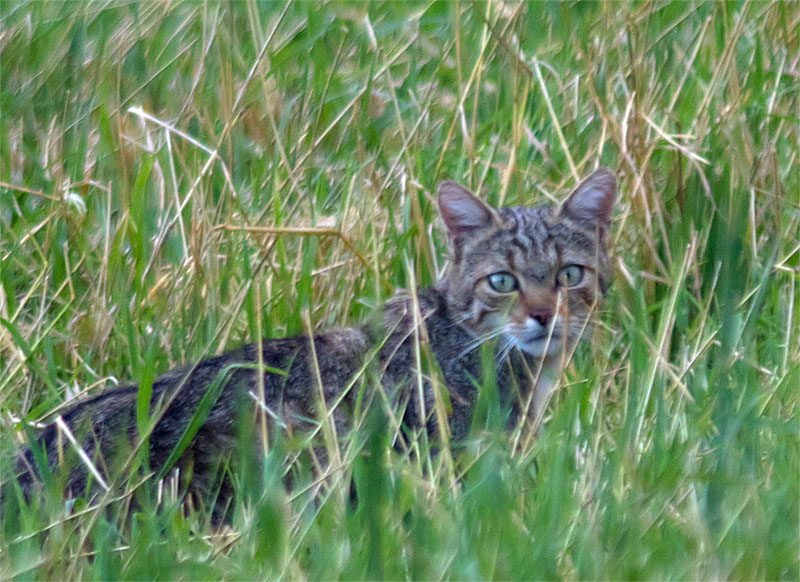
Amazing photos and post, Adele!
LikeLiked by 1 person
Thank you Pete. I was thrilled to see that wildcat.
LikeLiked by 1 person
Adele, very interesting post! I didn’t know there was a wild cat like that! Thanks for the lesson! Glad you at least got a glimpse of a bear!
LikeLiked by 1 person
Thanks Robin. Yes, most of the 40 or so members of the cat family get very little publicity – lions and tigers might be world famous, but forest wildcats, golden cats and fishing cats rarely show up in wildlife documentaries. Most of them are very shy and still poorly understood.
LikeLike
epost, Adele … when I saw the bear track, I thought “That’s a small brownie … our grizzlies certainly are bigger than that!” Brownies are “little” in comparison, and I’d assume that these are more used to living near people, but still nothing to fool with, despite their shyness. I love ’em!
When I saw the picture of the cat, my first thought was “Scotland!” … it was a surprise to learn that they were in the Balkans as well.
That shot of the forest glade is a knockout!
LikeLiked by 1 person
Thanks!
Yeah, these bears are much smaller than a griz, but I’m pretty sure that track was from a subadult. I did find a few fairly large (male?) footprints. I wonder how much of it is genetic as opposed to the fact that they cannot gorge themselves on spawning salmon there!
Forest wildcats were once found throughout the European wildwood but their distribution is very patchy now. They are also found in parts of Spain and Germany, and elsewhere. My high point of last summer’s expedition to Croatia was catching a female wildcat and a kitten on a trail camera.
LikeLike
Well, my pooter is playing tricks again … my first sentence was supposed to say: “Very nice post, Adele” …
LikeLiked by 1 person
When I was young, every summer my brother and I would go to Croatia, where our grandmother lived, in area just north of where you have been this year. Wolves, wild boars, bears, deer, lynx… you name it, it could be found there. I used to go to forest a lot, hiking alone or with some friends, and except for a few deer, I’ve never seen any other big animal, but the signs were everywhere – turned rocks, uprooted plants, scratched trees. Funny, I remember being more afraid to meet wild boar than bear, back then. Once, I was hiking alone and I’ve heard some loud crashing in a nearby bush, in my mind it was “BEAR” and, being young and naive, I climbed to a nearby tree 😀 Whatever it was, I’ve never seen it, but for a couple of minutes I regretted being there on my own.
Few years ago, population of bears just exploded in that area (Gorski Kotar), my friend told me they had 16 confirmed bears which is way too much, some of them moving even close to Adriatic coast (there is a photograph somewhere showing a brown bear in Crikvenica during the night https://www.24sata.hr/news/strah-na-ulici-djeca-su-bjezala-od-medvjeda-u-crikvenici-546524 and unfortunately, I think they will have to kill it).
But for 42 years of my life in ex-YU, I’ve seen just a few bears, all of them in zoo. In just 6 years of my life in Canada, I’ve seen so many of them, I lost count. This is how wild it is still over here, as you know it. And I like it 🙂
LikeLiked by 1 person
There is something special about a forest where large carnivores live. There is a sense that it is just that bit more alive. You must have many amazing memories from walking those woods. I wonder why bears are congregating in that area now – perhaps one of their natural food resources has failed.
That Mesendorf bear remains the only one I’ve seen in Europe, although I caught one on a camera trap in Poland last year. Some of the other staff went out with that driver on another day and saw a bear with cubs…but they didn’t get the dazzling weather, LOL.
Canada’s wilderness is a global treasure. Flying across it is something you never forget. As you know, there are so many trails and hidden valleys and lakes – it would take many lifetimes to explore all of it.
LikeLike
Dare, were you, perhaps in the area of Croatia known as “Plitvice”? It is a preserve area which sounds very much like what you describe … and you were right to be afraid of boars; they are very dangerous, and have nasty tempers. Avoiding them is a good policy. Bears are a little more reasonable, unless you come between a mother and her cub.
LikeLike
No, the part of Croatia where I spent my summers is called Gorski Kotar and its administrative borders start about 20km north-west from Plitvice. Never had a chance to visit the park though, even though I was passing by few times at the end of 80s.
When war in Bosnia was in a full scale during 90s, many animals tried to escape – and did so – the war zones and moved into Gorski Kotar. That might be a reason for increased bear and wolf population. I can imagine how frightened they must have been…
LikeLike
Yes; heavy artillery is only reassuring if you’re the one shooting it.
LikeLike
I can imagine that the Balkans wars were highly disruptive to wildlife for many reasons. Of course, one particularly grim legacy of it in Croatia is the profusion of landmines in many regions. Krka National Park, where I was based, was only declared landmine-free quite recently. The active fields elsewhere are supposed to be marked with signposts, but apparently some people steal the signs, and wildlife and livestock cannot read anyway.
LikeLike
Hi Adele!
What a luck to see a wild cat AND have time to take this nice pictures!
Meșendorf has a very nice location in Transylvania, close to Sighișoara and meantime a bit farther away from the big cities. So I’d say there is less prssure on the wildlife also. I remember first time seing a bear I was hiking in Romania with a friend, in Bucegi Mountains and a cub was just crossing an alpine valley that we were descending on. What an emotional moment! In the meantime I saw many bears in Romania, but always there’s a spark of an emotion seing this majestic animal. I’ve seen wolfs from far away but I wish I can see a wild cat and a lynx, in the wilderness, someday.
LikeLiked by 1 person
Hi Radu, thank you for your comment! I was thrilled to see this wildcat – it’s the only one that I’ve ever seen, although I’ve caught quite a few on camera traps. It sounds like you have had some magical sightings in this very special country. I hope you find a lynx!
LikeLike